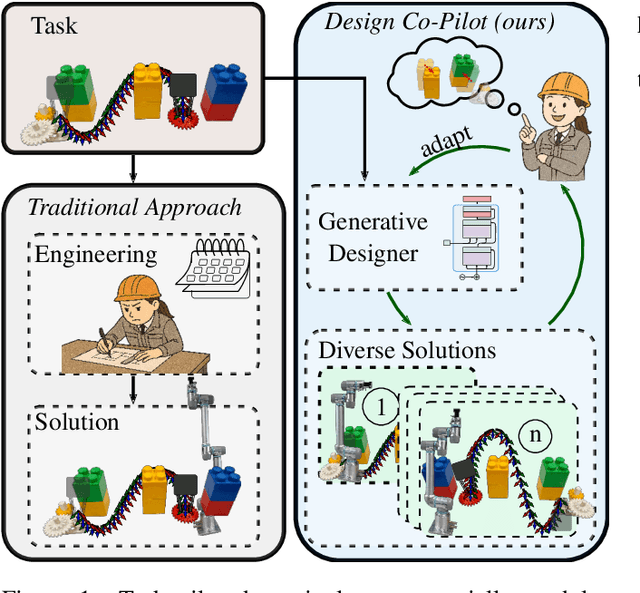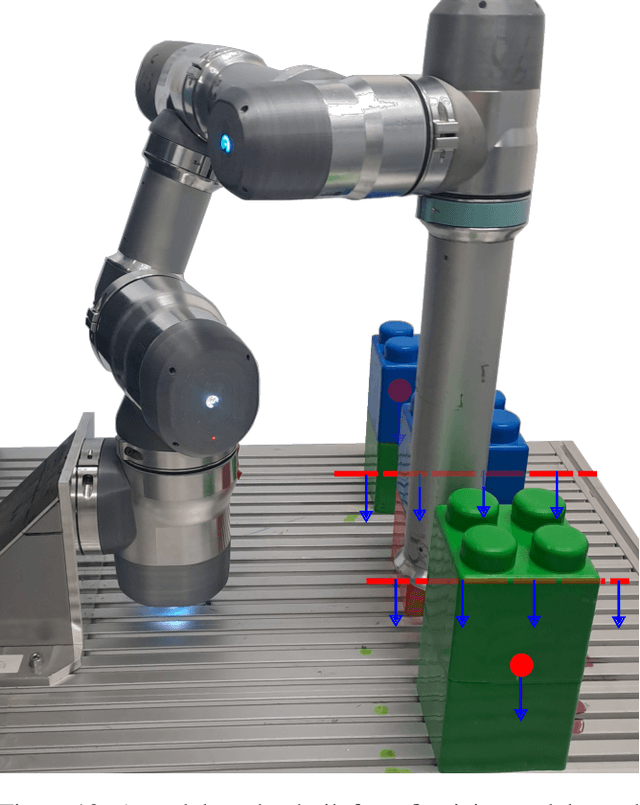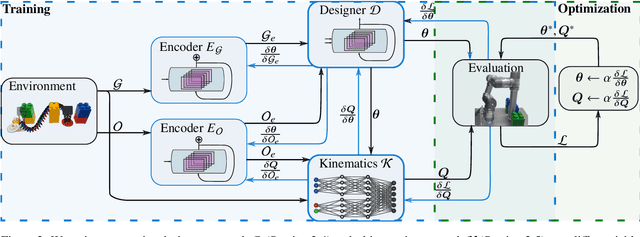Sehoon Ha
Georgia Tech
A Design Co-Pilot for Task-Tailored Manipulators
Sep 16, 2025



Abstract:Although robotic manipulators are used in an ever-growing range of applications, robot manufacturers typically follow a ``one-fits-all'' philosophy, employing identical manipulators in various settings. This often leads to suboptimal performance, as general-purpose designs fail to exploit particularities of tasks. The development of custom, task-tailored robots is hindered by long, cost-intensive development cycles and the high cost of customized hardware. Recently, various computational design methods have been devised to overcome the bottleneck of human engineering. In addition, a surge of modular robots allows quick and economical adaptation to changing industrial settings. This work proposes an approach to automatically designing and optimizing robot morphologies tailored to a specific environment. To this end, we learn the inverse kinematics for a wide range of different manipulators. A fully differentiable framework realizes gradient-based fine-tuning of designed robots and inverse kinematics solutions. Our generative approach accelerates the generation of specialized designs from hours with optimization-based methods to seconds, serving as a design co-pilot that enables instant adaptation and effective human-AI collaboration. Numerical experiments show that our approach finds robots that can navigate cluttered environments, manipulators that perform well across a specified workspace, and can be adapted to different hardware constraints. Finally, we demonstrate the real-world applicability of our method by setting up a modular robot designed in simulation that successfully moves through an obstacle course.
EMMA: Scaling Mobile Manipulation via Egocentric Human Data
Sep 04, 2025Abstract:Scaling mobile manipulation imitation learning is bottlenecked by expensive mobile robot teleoperation. We present Egocentric Mobile MAnipulation (EMMA), an end-to-end framework training mobile manipulation policies from human mobile manipulation data with static robot data, sidestepping mobile teleoperation. To accomplish this, we co-train human full-body motion data with static robot data. In our experiments across three real-world tasks, EMMA demonstrates comparable performance to baselines trained on teleoperated mobile robot data (Mobile ALOHA), achieving higher or equivalent task performance in full task success. We find that EMMA is able to generalize to new spatial configurations and scenes, and we observe positive performance scaling as we increase the hours of human data, opening new avenues for scalable robotic learning in real-world environments. Details of this project can be found at https://ego-moma.github.io/.
Unsupervised Skill Discovery as Exploration for Learning Agile Locomotion
Aug 12, 2025Abstract:Exploration is crucial for enabling legged robots to learn agile locomotion behaviors that can overcome diverse obstacles. However, such exploration is inherently challenging, and we often rely on extensive reward engineering, expert demonstrations, or curriculum learning - all of which limit generalizability. In this work, we propose Skill Discovery as Exploration (SDAX), a novel learning framework that significantly reduces human engineering effort. SDAX leverages unsupervised skill discovery to autonomously acquire a diverse repertoire of skills for overcoming obstacles. To dynamically regulate the level of exploration during training, SDAX employs a bi-level optimization process that autonomously adjusts the degree of exploration. We demonstrate that SDAX enables quadrupedal robots to acquire highly agile behaviors including crawling, climbing, leaping, and executing complex maneuvers such as jumping off vertical walls. Finally, we deploy the learned policy on real hardware, validating its successful transfer to the real world.
Learning Physical Interaction Skills from Human Demonstrations
Jul 28, 2025Abstract:Learning physical interaction skills, such as dancing, handshaking, or sparring, remains a fundamental challenge for agents operating in human environments, particularly when the agent's morphology differs significantly from that of the demonstrator. Existing approaches often rely on handcrafted objectives or morphological similarity, limiting their capacity for generalization. Here, we introduce a framework that enables agents with diverse embodiments to learn wholebbody interaction behaviors directly from human demonstrations. The framework extracts a compact, transferable representation of interaction dynamics, called the Embedded Interaction Graph (EIG), which captures key spatiotemporal relationships between the interacting agents. This graph is then used as an imitation objective to train control policies in physics-based simulations, allowing the agent to generate motions that are both semantically meaningful and physically feasible. We demonstrate BuddyImitation on multiple agents, such as humans, quadrupedal robots with manipulators, or mobile manipulators and various interaction scenarios, including sparring, handshaking, rock-paper-scissors, or dancing. Our results demonstrate a promising path toward coordinated behaviors across morphologically distinct characters via cross embodiment interaction learning.
PreCi: Pretraining and Continual Improvement of Humanoid Locomotion via Model-Assumption-Based Regularization
Apr 14, 2025



Abstract:Humanoid locomotion is a challenging task due to its inherent complexity and high-dimensional dynamics, as well as the need to adapt to diverse and unpredictable environments. In this work, we introduce a novel learning framework for effectively training a humanoid locomotion policy that imitates the behavior of a model-based controller while extending its capabilities to handle more complex locomotion tasks, such as more challenging terrain and higher velocity commands. Our framework consists of three key components: pre-training through imitation of the model-based controller, fine-tuning via reinforcement learning, and model-assumption-based regularization (MAR) during fine-tuning. In particular, MAR aligns the policy with actions from the model-based controller only in states where the model assumption holds to prevent catastrophic forgetting. We evaluate the proposed framework through comprehensive simulation tests and hardware experiments on a full-size humanoid robot, Digit, demonstrating a forward speed of 1.5 m/s and robust locomotion across diverse terrains, including slippery, sloped, uneven, and sandy terrains.
Tactile sensing enables vertical obstacle negotiation for elongate many-legged robots
Apr 11, 2025Abstract:Many-legged elongated robots show promise for reliable mobility on rugged landscapes. However, most studies on these systems focus on motion planning in the 2D horizontal plane (e.g., translation and rotation) without addressing rapid vertical motion. Despite their success on mild rugged terrains, recent field tests reveal a critical need for 3D behaviors (e.g., climbing or traversing tall obstacles) in real-world application. The challenges of 3D motion planning partially lie in designing sensing and control for a complex high-degree-of-freedom system, typically with over 25 degrees of freedom. To address the first challenge, we propose a tactile antenna system that enables the robot to probe obstacles and gather information about the structure of the environment. Building on this sensory input, we develop a control framework that integrates data from the antenna and foot contact sensors to dynamically adjust the robot's vertical body undulation for effective climbing. With the addition of simple, low-bandwidth tactile sensors, a robot with high static stability and redundancy exhibits predictable climbing performance in complex environments using a simple feedback controller. Laboratory and outdoor experiments demonstrate the robot's ability to climb obstacles up to five times its height. Moreover, the robot exhibits robust climbing capabilities on obstacles covered with flowable, robot-sized random items and those characterized by rapidly changing curvatures. These findings demonstrate an alternative solution to perceive the environment and facilitate effective response for legged robots, paving ways towards future highly capable, low-profile many-legged robots.
Learning a High-quality Robotic Wiping Policy Using Systematic Reward Analysis and Visual-Language Model Based Curriculum
Feb 18, 2025Abstract:Autonomous robotic wiping is an important task in various industries, ranging from industrial manufacturing to sanitization in healthcare. Deep reinforcement learning (Deep RL) has emerged as a promising algorithm, however, it often suffers from a high demand for repetitive reward engineering. Instead of relying on manual tuning, we first analyze the convergence of quality-critical robotic wiping, which requires both high-quality wiping and fast task completion, to show the poor convergence of the problem and propose a new bounded reward formulation to make the problem feasible. Then, we further improve the learning process by proposing a novel visual-language model (VLM) based curriculum, which actively monitors the progress and suggests hyperparameter tuning. We demonstrate that the combined method can find a desirable wiping policy on surfaces with various curvatures, frictions, and waypoints, which cannot be learned with the baseline formulation. The demo of this project can be found at: https://sites.google.com/view/highqualitywiping.
PrivilegedDreamer: Explicit Imagination of Privileged Information for Rapid Adaptation of Learned Policies
Feb 17, 2025Abstract:Numerous real-world control problems involve dynamics and objectives affected by unobservable hidden parameters, ranging from autonomous driving to robotic manipulation, which cause performance degradation during sim-to-real transfer. To represent these kinds of domains, we adopt hidden-parameter Markov decision processes (HIP-MDPs), which model sequential decision problems where hidden variables parameterize transition and reward functions. Existing approaches, such as domain randomization, domain adaptation, and meta-learning, simply treat the effect of hidden parameters as additional variance and often struggle to effectively handle HIP-MDP problems, especially when the rewards are parameterized by hidden variables. We introduce Privileged-Dreamer, a model-based reinforcement learning framework that extends the existing model-based approach by incorporating an explicit parameter estimation module. PrivilegedDreamer features its novel dual recurrent architecture that explicitly estimates hidden parameters from limited historical data and enables us to condition the model, actor, and critic networks on these estimated parameters. Our empirical analysis on five diverse HIP-MDP tasks demonstrates that PrivilegedDreamer outperforms state-of-the-art model-based, model-free, and domain adaptation learning algorithms. Additionally, we conduct ablation studies to justify the inclusion of each component in the proposed architecture.
RobotMover: Learning to Move Large Objects by Imitating the Dynamic Chain
Feb 07, 2025Abstract:Moving large objects, such as furniture, is a critical capability for robots operating in human environments. This task presents significant challenges due to two key factors: the need to synchronize whole-body movements to prevent collisions between the robot and the object, and the under-actuated dynamics arising from the substantial size and weight of the objects. These challenges also complicate performing these tasks via teleoperation. In this work, we introduce \method, a generalizable learning framework that leverages human-object interaction demonstrations to enable robots to perform large object manipulation tasks. Central to our approach is the Dynamic Chain, a novel representation that abstracts human-object interactions so that they can be retargeted to robotic morphologies. The Dynamic Chain is a spatial descriptor connecting the human and object root position via a chain of nodes, which encode the position and velocity of different interaction keypoints. We train policies in simulation using Dynamic-Chain-based imitation rewards and domain randomization, enabling zero-shot transfer to real-world settings without fine-tuning. Our approach outperforms both learning-based methods and teleoperation baselines across six evaluation metrics when tested on three distinct object types, both in simulation and on physical hardware. Furthermore, we successfully apply the learned policies to real-world tasks, such as moving a trash cart and rearranging chairs.
Understanding Expectations for a Robotic Guide Dog for Visually Impaired People
Jan 08, 2025



Abstract:Robotic guide dogs hold significant potential to enhance the autonomy and mobility of blind or visually impaired (BVI) individuals by offering universal assistance over unstructured terrains at affordable costs. However, the design of robotic guide dogs remains underexplored, particularly in systematic aspects such as gait controllers, navigation behaviors, interaction methods, and verbal explanations. Our study addresses this gap by conducting user studies with 18 BVI participants, comprising 15 cane users and three guide dog users. Participants interacted with a quadrupedal robot and provided both quantitative and qualitative feedback. Our study revealed several design implications, such as a preference for a learning-based controller and a rigid handle, gradual turns with asymmetric speeds, semantic communication methods, and explainability. The study also highlighted the importance of customization to support users with diverse backgrounds and preferences, along with practical concerns such as battery life, maintenance, and weather issues. These findings offer valuable insights and design implications for future research and development of robotic guide dogs.
 Add to Chrome
Add to Chrome Add to Firefox
Add to Firefox Add to Edge
Add to Edge